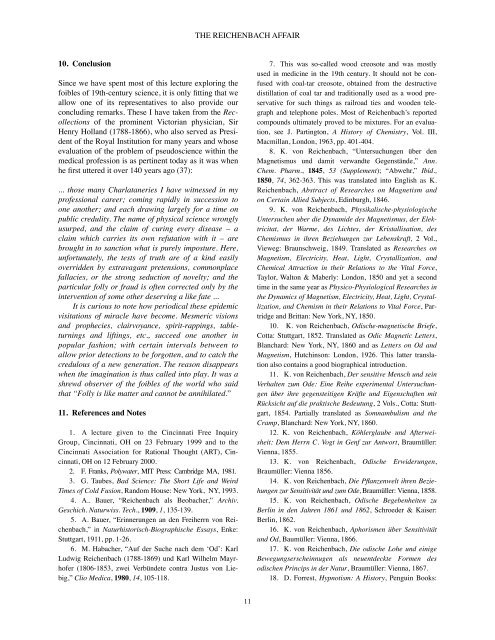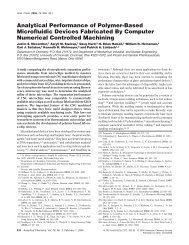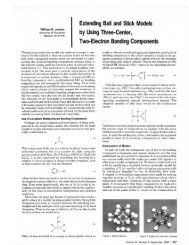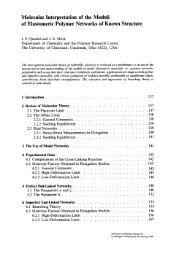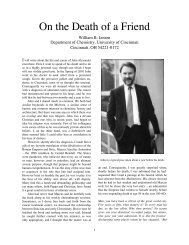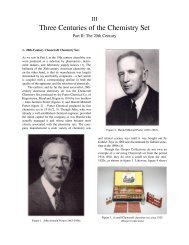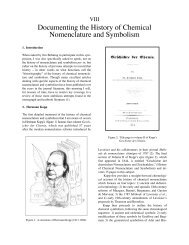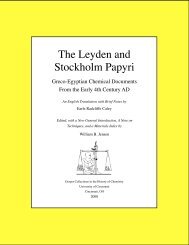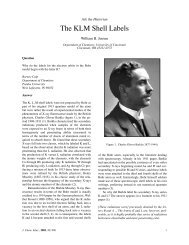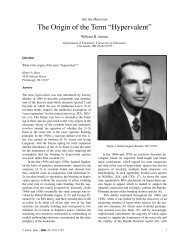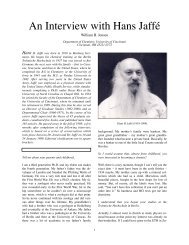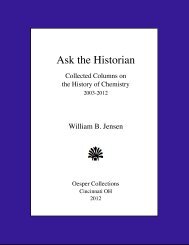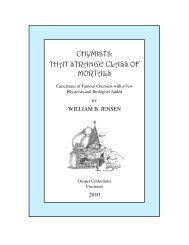Frankenstein's Cat.pdf - University of Cincinnati
Frankenstein's Cat.pdf - University of Cincinnati
Frankenstein's Cat.pdf - University of Cincinnati
Create successful ePaper yourself
Turn your PDF publications into a flip-book with our unique Google optimized e-Paper software.
THE REICHENBACH AFFAIR<br />
10. Conclusion<br />
Since we have spent most <strong>of</strong> this lecture exploring the<br />
foibles <strong>of</strong> 19th-century science, it is only fitting that we<br />
allow one <strong>of</strong> its representatives to also provide our<br />
concluding remarks. These I have taken from the Recollections<br />
<strong>of</strong> the prominent Victorian physician, Sir<br />
Henry Holland (1788-1866), who also served as President<br />
<strong>of</strong> the Royal Institution for many years and whose<br />
evaluation <strong>of</strong> the problem <strong>of</strong> pseudoscience within the<br />
medical pr<strong>of</strong>ession is as pertinent today as it was when<br />
he first uttered it over 140 years ago (37):<br />
... those many Charlataneries I have witnessed in my<br />
pr<strong>of</strong>essional career; coming rapidly in succession to<br />
one another; and each drawing largely for a time on<br />
public credulity. The name <strong>of</strong> physical science wrongly<br />
usurped, and the claim <strong>of</strong> curing every disease – a<br />
claim which carries its own refutation with it – are<br />
brought in to sanction what is purely imposture. Here,<br />
unfortunately, the tests <strong>of</strong> truth are <strong>of</strong> a kind easily<br />
overridden by extravagant pretensions, commonplace<br />
fallacies, or the strong seduction <strong>of</strong> novelty; and the<br />
particular folly or fraud is <strong>of</strong>ten corrected only by the<br />
intervention <strong>of</strong> some other deserving a like fate ...<br />
! It is curious to note how periodical these epidemic<br />
visitations <strong>of</strong> miracle have become. Mesmeric visions<br />
and prophecies, clairvoyance, spirit-rappings, tableturnings<br />
and liftings, etc., succeed one another in<br />
popular fashion; with certain intervals between to<br />
allow prior detections to be forgotten, and to catch the<br />
credulous <strong>of</strong> a new generation. The reason disappears<br />
when the imagination is thus called into play. It was a<br />
shrewd observer <strong>of</strong> the foibles <strong>of</strong> the world who said<br />
that “Folly is like matter and cannot be annihilated.”<br />
11. References and Notes<br />
! 1.! A lecture given to the <strong>Cincinnati</strong> Free Inquiry<br />
Group, <strong>Cincinnati</strong>, OH on 23 February 1999 and to the<br />
<strong>Cincinnati</strong> Association for Rational Thought (ART), <strong>Cincinnati</strong>,<br />
OH on 12 February 2000.<br />
! 2.! F. Franks, Polywater, MIT Press: Cambridge MA, 1981.!<br />
! 3. G. Taubes, Bad Science: The Short Life and Weird<br />
Times <strong>of</strong> Cold Fusion, Random House: New York, NY, 1993.<br />
! 4.! A.. Bauer, “Reichenbach als Beobacher,” Archiv.<br />
Geschich. Naturwiss. Tech., 1909, 1, 135-139.<br />
! 5.! A. Bauer, “Erinnerungen an den Freiherrn von Reichenbach,”<br />
in Naturhistorisch-Biographische Essays, Enke:<br />
Stuttgart, 1911, pp. 1-26.<br />
! 6.! M. Habacher, “Auf der Suche nach dem ‘Od’: Karl<br />
Ludwig Reichenbach (1788-1869) und Karl Wilhelm Mayrh<strong>of</strong>er<br />
(1806-1853, zwei Verbündete contra Justus von Liebig,”<br />
Clio Medica, 1980, 14, 105-118.<br />
! 7.! This was so-called wood creosote and was mostly<br />
used in medicine in the 19th century. It should not be confused<br />
with coal-tar creosote, obtained from the destructive<br />
distillation <strong>of</strong> coal tar and traditionally used as a wood preservative<br />
for such things as railroad ties and wooden telegraph<br />
and telephone poles. Most <strong>of</strong> Reichenbach’s reported<br />
compounds ultimately proved to be mixtures. For an evaluation,<br />
see J. Partington, A History <strong>of</strong> Chemistry, Vol. III,<br />
Macmillan, London, 1963, pp. 401-404.<br />
! 8.! K. von Reichenbach, “Untersuchungen über den<br />
Magnetismus und damit verwandte Gegenstände,” Ann.<br />
Chem. Pharm., 1845, 53 (Supplement); “Abwehr,” Ibid.,<br />
1850, 74, 362-363. This was translated into English as K.<br />
Reichenbach, Abstract <strong>of</strong> Researches on Magnetism and<br />
on Certain Allied Subjects, Edinburgh, 1846.<br />
! 9. ! K. von Reichenbach, Physikalische-physiologische<br />
Untersuchen uber die Dynamide des Magnetismus, der Elektricitat,<br />
der Warme, des Lichtes, der Kristallisation, des<br />
Chemismus in ihren Beziehungen zur Lebenskraft, 2 Vol.,<br />
Vieweg: Braunschweig, 1849. Translated as Researches on<br />
Magnetism, Electricity, Heat, Light, Crystallization, and<br />
Chemical Attraction in their Relations to the Vital Force,<br />
Taylor, Walton & Maberly: London, 1850 and yet a second<br />
time in the same year as Physico-Physiological Researches in<br />
the Dynamics <strong>of</strong> Magnetism, Electricity, Heat, Light, Crystallization,<br />
and Chemism in their Relations to Vital Force, Partridge<br />
and Brittan: New York, NY, 1850.<br />
! 10.! K. von Reichenbach, Odische-magnetische Briefe,<br />
Cotta: Stuttgart, 1852. Translated as Odic Magnetic Letters,<br />
Blanchard: New York, NY, 1860 and as Letters on Od and<br />
Magnetism, Hutchinson: London, 1926. This latter translation<br />
also contains a good biographical introduction.<br />
! 11.! K. von Reichenbach, Der sensitive Mensch und sein<br />
Verhalten zum Ode: Eine Reihe experimental Untersuchungen<br />
über ihre gegensteitigen Kräfte und Eigenschaften mit<br />
Rücksicht auf die praktische Bedeutung, 2 Vols., Cotta: Stuttgart,<br />
1854. Partially translated as Somnambulism and the<br />
Cramp, Blanchard: New York, NY, 1860.<br />
! 12. K. von Reichenbach, Köhlerglaube und Afterweisheit:<br />
Dem Herrn C. Vogt in Genf zur Antwort, Braumüller:<br />
Vienna, 1855.<br />
! 13.! K. von Reichenbach, Odische Erwiderungen,<br />
Braumüller: Vienna 1856.<br />
! 14.! K. von Reichenbach, Die Pflanzenwelt ihren Beziehungen<br />
zur Sensitivität und zum Ode, Braumüller: Vienna, 1858.<br />
! 15.! K. von Reichenbach, Odische Begebenheiten zu<br />
Berlin in den Jahren 1861 und 1862, Schroeder & Kaiser:<br />
Berlin, 1862.<br />
! 16.! K. von Reichenbach, Aphorismen über Sensitivität<br />
und Od, Baumüller: Vienna, 1866.<br />
! 17.! K. von Reichenbach, Die odische Lohe und einige<br />
Bewegungserscheinnugen als neuentdeckte Formen des<br />
odischen Princips in der Natur, Braumüller: Vienna, 1867.<br />
! 18.! D. Forrest, Hypnotism: A History, Penguin Books:<br />
11


